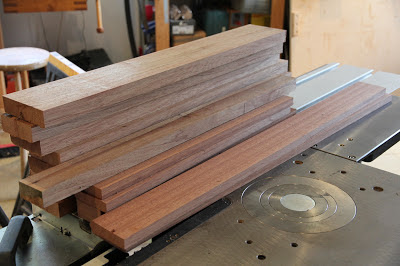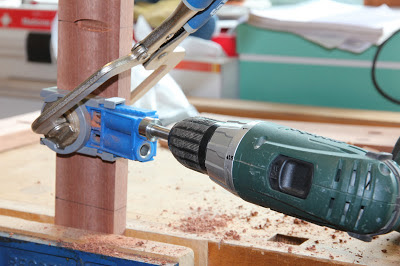Much as I love planes, one problem is that they tend to produce straight square surfaces which are very inorganic and can be rather sterile in appearance. Great designs (of which this turned out not to be one), which pass test of time, tend to incorporate curves.
I had a family brief to make an outdoor table to go with a curved teak bench not more than 850mm long and be about 500mm high. That is rather high for such a small table and was to lead to problems later......
The material was entirely re-cycled Everest window boards and frames (for which there is no fate too horrible) and although the timber was technically hardwood, it had a consistency nearer to compressed cardboard. It appeared to be a low grade Sapele with the mandatory alternating grain.
The unpromising raw material
A bit of nervous nail avoidance and normal processing produced a pile of semi-decent raw material
Tenoning the ends was done single sided on the spindle then flipped to ensure the tenon was central. The false fence keeps everything under control and reduces the tendency to break out.
I tried PU foaming glue for the first time as it is supposed to be good for outside work. I don't like it as it is difficult to keep it off the surfaces as it foams and you then have a significant clean-up job afterwards. I gather you can wipe it off with acetone but I didn't have any to hand.
I spaced the slats with 8mm drills as per the drawing and it seemed to work out.
Owing to the curved end on the rail I had to use one side only of the narrow parts jig but this worked out fine.
Next came the end rails, dominoed to the legs. I decided to Kreg screw each slat to the rails so that they would be secure even if the glue began to fail. I also popped a Kreg into each leg.
The drill is not at an angle but I had to let go to take the picture!!
Finally a clean up before glueing up the frame. The aforementioned timber required the services of the BU smoother at high pitch to deal with the interlocked grain and I used my patent full width bench stop which is less likely to allow the component to slip off (especially with panels)
I think the main problem is the heavy frame could take a larger top but that was pre-determined. I like the combination of tapered legs and curved rails but would refine the proportions next time.
I realise it is not to everyone's taste but it's a bit quirky and it's growing on me. It is finished in Sikkens Cetol Marine (a yacht varnish) for outside survival.
Thanks for looking an please post your opinions - I really am interested and pleased to receive them, good or bad.
I had a family brief to make an outdoor table to go with a curved teak bench not more than 850mm long and be about 500mm high. That is rather high for such a small table and was to lead to problems later......
The material was entirely re-cycled Everest window boards and frames (for which there is no fate too horrible) and although the timber was technically hardwood, it had a consistency nearer to compressed cardboard. It appeared to be a low grade Sapele with the mandatory alternating grain.
The unpromising raw material
A bit of nervous nail avoidance and normal processing produced a pile of semi-decent raw material
I intended to use templates to form the curves and use the rebate block with bearings or the Felder router spindle with a template cutter. I decided to start with the top first and made up some templates from MDF for the tapered outer rails and curved ends.
This initially required some school geometry to mark out. The multiple lines are other projects and ideas, not mistakes!!
I used the highly advanced batten and nail to mark the end radii and a bearing ring to blend the corners.
Completed template for the end. I made this full width to check the appearance although I would only use half the width at time before reversing the piece to run with the grain down both sides.
I made a double sided template to curve the outside rails, inner and outer.
And a similar template for the frame rails.
I glued up some blocks to make the curved section as I was short of wide boards and tenonned the ends on the spindle before shaping, using a false fence. I experimented with the, now superseded, Felder plastic anti-breakout block which worked well without a backing piece, just grazing the blade harmlessly.
Tenoning the ends was done single sided on the spindle then flipped to ensure the tenon was central. The false fence keeps everything under control and reduces the tendency to break out.
Here is a video of some of the moulding. I didn't have a suitable guard, but on template work it is possible to keep your digits a long way from the cutter, safely behind the template.
I suppose I should say the guards were removed for photography - but they weren't.
Time to break out the spokeshaves for a clean up of the moulded edges. There have been several recent forum threads about the horrors of the spokeshave but I find if they are sharp, finely set and used skewed they are versatile and effective tools. In fact I enjoy using them and they enable many creative possibilities away from the "straight and narrow".
Excuse the exposed biscuit we can't all be perfect :-(
A dry run to see how it went together.
I spaced the slats with 8mm drills as per the drawing and it seemed to work out.
Once I'd cleaned off all the damned glue I set about chamfering the underside of the edge. I intended to use a tapered router bit in the spindle but it proved difficult to control with the weight of the top and the curves fell into the spindle aperture. I could have made up a full false fence but this was difficult with a bearing guided cutter so I marked it with a gauge and used the flat spokeshave which was quicker and easier.
I wanted to test some ideas on leg support using the minimum of cross rails and thought of a widish central spacer to prevent racking, between the side rails, which would transfer loads to all four legs whilst leaving the ends clear.
With the top made I turned my attention to the legs. I didn't see any point in thinning down the stock too much as they were 460 high and largely unsupported but this later contributed to the heaviness of the under frame appearance, so filed for future reference. The Finn Juhl method of a separate stiffener at right angles solves the problem nicely (see separate post on FJ table.)
I had made up a full size rod to prevent mistakes and transferred the angles on the ends of the legs before trimming to length on the dimension saw, using the angled fence.
I started the long sides on the taper jig and cut out the blanks. I would normally use a crown guard with extraction but Doug had tidied it away to a place which I had not yet found :-) (I have now)
I profiled the side rails in the same way as the top and set out the joints which were dominoed but with Sapele doms to withstand the outside environment.
Owing to the curved end on the rail I had to use one side only of the narrow parts jig but this worked out fine.
Next came the end rails, dominoed to the legs. I decided to Kreg screw each slat to the rails so that they would be secure even if the glue began to fail. I also popped a Kreg into each leg.
The drill is not at an angle but I had to let go to take the picture!!
Finally a clean up before glueing up the frame. The aforementioned timber required the services of the BU smoother at high pitch to deal with the interlocked grain and I used my patent full width bench stop which is less likely to allow the component to slip off (especially with panels)
The bench stop
As is my habit, I glued up on the building board to keep everything flat and true.
More bubbling squeeze to deal with.
It took ages to clean up but the joints seem strong. I am using the top as a stressed member (much like Tim Yeo today :-))) to minimise framework, but the loads are shared between all the members and the finished table is very rigid.
I think the main problem is the heavy frame could take a larger top but that was pre-determined. I like the combination of tapered legs and curved rails but would refine the proportions next time.
I realise it is not to everyone's taste but it's a bit quirky and it's growing on me. It is finished in Sikkens Cetol Marine (a yacht varnish) for outside survival.
Thanks for looking an please post your opinions - I really am interested and pleased to receive them, good or bad.




























4 comments:
That looks nice, Brian. I've used quite a lot of reclaimed Sapele and found it not very nice to work because the grain is all over the place, but if you manage to tame it (as you clearly have), the finished result looks good.
Cheers ;-)
Paul Chapman
What a handsome table!
Looks good. I'd have oiled it myself, but I've got a bit of a thing about linseed for everything!
pretty impressive.
Post a Comment